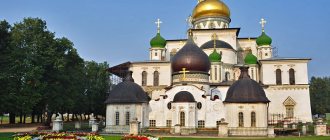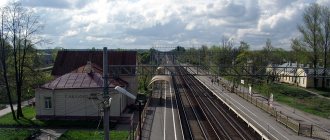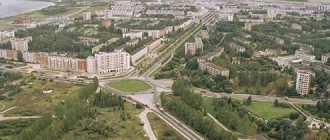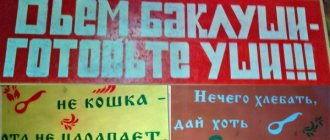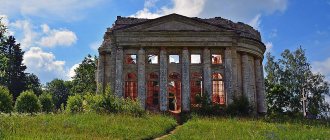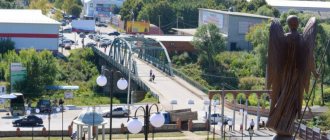- home
- >
- Advantages
- >
- Attractions
Zaoksky region is rich in interesting historical places of great cultural value. One of the most striking examples is the museum-estate of the great Russian artist V. D. Polenov
. The main building of the estate was made in a very original architectural style according to the design of the painter himself in 1892. The main purpose of the house was to serve as an art workshop. Many artists, sculptors and craftsmen work here to this day. And museum visitors can purchase unique souvenirs as souvenirs. Today the museum is one of the most famous museum-reserves in Russia.
No less famous is the museum-estate of the famous Russian scientist, writer and encyclopedist A. T. Bolotov
in Dvoryaninovo. In terms of his contribution to Russian science, he was often compared to Lomonosov. During the tour of the museum-reserve, you can swim in the estate ponds, as well as purchase souvenirs and medicinal herbs.
And in the village of Savino there is a house-museum of the hero of the Russian-Japanese War V. F. Rudnev
. Here you can get acquainted not only with the outstanding personality of the rear admiral, but also with the history of the navy. Not far from the museum building is the grave of V. F. Rudnev.
There are many ancient Orthodox churches in the Zaoksky district. In the village of Bekhovo there is the Church of the Life-Giving Trinity, built according to the design of V. D. Polenov. Also nearby is the Holy Spring at the site of the appearance of the Kazan Icon of the Mother of God, known for its healing power.
Welcome to Zaoksky district!
Polenov Museum - the pearl of the Zaoksky region
Today, the Zaoksky district is becoming more and more attractive for residents of the capital who want to buy a dacha in an ecologically clean region away from the metropolis. In connection with the expansion of Moscow, there is an increase in the cost of plots in the southern direction, along the Simferopol Highway. This trend is forcing many to take a fresh look at the so-called “distant dachas”, because 100 km from the Moscow Ring Road is just an hour’s drive without traffic jams! But in addition to the purely economic component, an important factor in the popularity of the Zaoksky district is its cultural significance
. On Zaokskaya land there are two largest museums in central Russia - the artist V.D. Polenov and agronomist A.T. Bolotova. Today we will talk about a monument of cultural heritage of national scale - the museum-reserve of Vasily Dmitrievich Polenov.
The charm of Oka
It is no coincidence that Moscow residents are so fond of the resorts and nature of the Zaoksky district. It’s really hard not to fall in love with these picturesque places! Writer Konstantin Paustovsky wrote: “Perhaps, nowhere near Moscow were there places so typically and touchingly Russian in their landscape.” The eye here makes many bends, creating unique views. And the healing air in its properties is not inferior to the resorts of Switzerland!
It is not surprising that the great Russian artist Vasily Dmitrievich Polenov
, - and he was not even a Muscovite, but a St. Petersburger, - sailing along the Oka, he exclaimed: “This is such a place, this is such freedom, and the Oka, what a beauty!” And the painter remained on the Zaoksk land forever, creating his world-famous estate on the right bank of the Oka, not far from the town of Velegozh.
Polenov's creative path
Vasily Dmitrievich Polenov is a major figure in Russian landscape painting. He was born on May 20, 1844 in St. Petersburg into a noble family. Beginning in 1863, Polenov attended the Academy of Arts, although he received his education at the faculties of physics, mathematics and law. In 1867, Polenov visited the World Art Exhibition in Paris and over the next decade constantly honed his skills in the capitals of European painting - Florence, Naples, Venice, Vienna and Munich. During the Russian-Turkish War, Vasily Polenov was an official artist under the future Emperor Alexander III.
In 1878, Polenov presented to the public perhaps his most famous painting, “Moscow Courtyard”
, which achieves literally resounding success and brings the artist truly worldwide fame.
In 1881 - 1882, Vasily Polenov went on a journey to biblical places and visited Constantinople, Palestine, Syria and Egypt. In 1882 - 1895 V.D. Polenov taught at the Moscow School of Painting, Sculpture and Architecture.
Polenovo Estate and Museum-Reserve
A real revolution in Polenov's life occurs in 1890, when he decides to purchase an estate on the banks of the Oka. Being a city dweller from birth, Polenov was very fond of the vast expanse of endless fields, dense deciduous forests descending to mighty rivers. And I always dreamed of settling in the lap of nature. In 1887, on the way to Crimea, Polenov saw the Oka from the window of a carriage and once and for all fell under the spell of this wondrous river.
“Beautiful places on the Oka near Serpukhov and beyond,” the artist wrote to his wife. “This is where we should settle.” And, a few days later, he returns to this topic: “I dreamed of a house on the banks of the Oka, how we would arrange it, how we would live there, make a large room where there would be a museum, a gallery and a library. Nearby there will be a carpentry workshop, the Admiralty, a fishery and a terrace, and above this there will be my painting workshop and your small office... Wonderful dreams, perhaps, will come true...”
Together with his student Konstantin Korovin, also a famous painter, Polenov again came to Bekhovo in May 1889: at that time, an impoverished landowner was selling a small neglected estate there. A year later, Polenov acquired this estate and built a house according to his own original design, as well as art workshops. The artist decided to name the estate “Borok”. According to Polenov’s plan, Borok was to become a “nest of artists”, and over time turn into the first provincial public museum. Polenov built a folk theater for peasants and a church in Bökhov.
Polenov took on the project of the house himself: architecture was partly an unfulfilled passion of the artist. The extraordinary abilities of Polenov as an architect were noted by I.E. Repin in his memoirs: “After all, he is an architect, and what a great one! While still a student at the Academy of Arts, he composed and edited architectural programs on a given topic for some architects, and they received medals and titles...”
Polenov's works are in striking contrast to what was generally accepted in estate architectural practice at that time, and anticipate the poetics of the Art Nouveau style in architecture. It would be more correct to call the style of Polenov’s architectural creativity “the style of different eras,” or even more precisely, the “Polenov style.”
In 1892, the Polenovsky Museum became the first art museum in a village in Russia, accessible to the widest range of visitors. Today it has the status of the state memorial historical, artistic and natural museum-reserve of Vasily Dmitrievich Polenov. Since 2011, the museum has been headed by the painter’s great-granddaughter Natalya Fedorovna Polenova. Of course, the Polenov museum-estate is a real pearl of the Zaoksky region. Go to the website of the V.D. Museum Polenova, and even better - buy a dacha on Zaokskaya land along the Simferopol highway and visit the cultural centers of the region at any time convenient for you!
Content
- 1 Church of the Life-Giving Trinity (Bekhovo)
- 2 Church of the Nativity of the Blessed Virgin Mary (Velegozh)
- 3 Church of the Intercession of the Blessed Virgin Mary (Volkovichi)
- 4 Temple of Demetrius of Rostov (Dmitrievskoye)
- 5 Temple of Michael the Archangel (Zaoksky)
- 6 Church of St. Nicholas the Wonderworker (Lighthouse)
- 7 Church of the Nativity of the Blessed Virgin Mary (Nikitino)
- 8 Temple of the Kazan Icon of the Mother of God (Savino)
- 9 Temple of the Icon of the Mother of God “The Sign” (Strakhovo)
- 10 Temple of Alexander the Roman (Chentsovo)
Bolotov's estate - the pride of Zaokskaya land
A.S. Pushkin, trying to show the enlightenment of his Onegin, said about him: “But I read Adam Smith and was a deep economist.” Andrey Timofeevich Bolotov
I also knew the Scottish economist as an older contemporary (in 1797 Bolotov was elected an honorary member of the Royal Saxon Leipzig Economic Society).
And in managing the farm he proved himself to be an equally experienced manager. However, the main merit of A.T. Bolotov became agronomy and botany
, in which he achieved great success and contributed to contemporary science! It is believed that it was Bolotov who had the greatest influence on tomatoes and potatoes being recognized as the popular agricultural crops that they are now, but which they were not yet in the 18th century...
Andrei Timofeevich was born on October 18, 1738 - very soon he will turn 280 years old! In less than a century of life - he did not live only two days before his 95th birthday - Bolotov established himself as the largest writer of his time, memoirist, moral philosopher and, of course, an agronomist.
Bolotov was born on his family estate Dvoryaninov
, which to this day is the real pride of the Zaokskaya land. Until the age of 12, the future scientist lived with his father Timofey Petrovich, who taught his son foreign languages, mathematics and geography. Subsequently, young Bolotov was sent to study with a Frenchman in St. Petersburg. At the age of 19, young Andrei Bolotov entered the service with the rank of second lieutenant and went to the Seven Years' War. In 1757 he went on guard duty in Königsberg, present-day Kaliningrad. There he became a translator and clerk under generals N.A. Korfe and V.I. Suvorov, who ruled the Kingdom of Königsberg.
In his free time from service, Andrei Timofeevich Bolotov continued his education and took lessons from professors at the University of Koenigsberg. Upon his return to Russia, Bolotov retired with the rank of captain and returned to his native Dvoryaninovo, where he devoted himself entirely to science. In his village, Bolotov began studying agriculture
, and along the way he published works on
moral philosophy and pedagogy
.
For a whole decade, from 1780 to 1790, A.T. Bolotov collaborated with N.I. Moskovskie Vedomosti. Novikova. In this magazine, Andrei Timofeevich published articles, the number of which by the end reached 4 thousand! Or - 40 separate volumes of an entire encyclopedia! Bolotov himself entitled this colossal publication as “a collection of all kinds of economic news, experiences, discoveries, notes, instructions, notes and advice related to agriculture, cattle breeding, gardens and orchards, meadows, forests, ponds, various products, village buildings, homemade medicines, medicinal herbs and all sorts of things necessary and inevitable for city and village residents.”
Bolotov lived almost continuously for decades in Dvoryaninov and here, in 1833, he found eternal peace. Andrei Timofeevich was buried in the cemetery of the village of Rusyatino in the Zaoksky district of the Tula region, two kilometers from Dvoryaninov. Bolotov's grave has survived to this day.
Church of the Nativity of the Blessed Virgin Mary (Velegozh)[edit]
The temple was built in 1731 at the request of Prince Ivan Trubetskoy on the site of a burnt wooden church. A rare example of Anninsky Baroque
During the Great Patriotic War, the front line passed along the Oka River, Velegozh was shot through, and shells hit the temple.
In 1961, the temple was closed and destroyed, the building was destroyed.
In 1991, it was returned to believers, and restoration work began.
Address:
Tula region, Zaoksky district, village of Velegozh
Car washes
- Car wash on Nechaevskoye Highway, 4. www.Moika71.rf . Wide range of services. Low prices. Discounts. Car wash address: Zaoksky village, Nechaevskoe highway, 4. Car wash phone number: +7-915-680-39-00. View the car wash website on the Internet (link).
- Truck car wash. Washing trucks up to 3 meters high. Cargo car wash address: Zaoksky village, Nechaevskoe highway, 4. Car wash phone number: +7-915-680-39-00. View the cargo wash website on the Internet (link).
Prices
Tickets can only be purchased in cash at the Polenovo Estate Tourist Center, and tickets for the Admiralty and Diorama can be purchased locally. Prices in excursion format, in rubles.
Entrance to the Big House:
- adults - 350;
- pensioners and students - 250;
- for schoolchildren (16-18 years old) - 150.
From 01.05 to 31.10, as well as on holidays and vacations, you can get to the Big House as part of excursion groups.
Tickets for the exhibition in Fachwerk:
- full - 250;
- preferential - 150;
- school - 50.
You can view the Diorama and exhibition at the Admiralty only as part of a guided tour. Prices for adults/students and pensioners/schoolchildren are 100/90/70 rubles.
Library, © POLENOVO
Tickets to the Abbey:
- adult - 250;
- for pensioners and students - 150;
- school - 50.
The following have the right of free entry (without excursions):
- children under 16 years of age and orphans;
- disabled people of I and II groups;
- participants in military operations and WWII;
- conscript soldiers.
Additional services:
- parking - 200 rubles;
- amateur photo/video shooting in interiors - 200/500 rubles;
- professional photography on request.
A more detailed price list is presented on the official website.
Exposition of events in Polenovo, © POLENOVO
General Mirkovich's estate and the Filimonovskaya Toy Museum
It’s good to combine these places into a general trip, because... they are very close to each other. The general’s estate is located in a village with the sonorous name of Nikolo-Zhupan, Odoevsky district, and the Filimonovskaya Toy museum is in Odoev itself.
The estate of General Mirkovich is another little-known landmark of the Tula province. Although it is a historical and cultural monument of federal significance, it is in absolutely deplorable condition.
At one time, two generals lived here, heroes of the Patriotic War of 1812 - Alexander and Fyodor Mirkovich. It was Alexander Yakovlevich Mirkovich who in 1851 turned this place into a real Russian estate. On a high hill he built a stone house with enfilades and an observation deck at the top, which offered stunning views of the area.
The views have been preserved, but in Soviet times the estate suffered the sad fate of noble estates. Various institutions were located here for a long time, which did not contribute to the preservation of the cultural monument.
Today, the general’s descendants are trying to restore the estate, but due to lack of funds, this process is moving very slowly. You can get inside only by prior arrangement, and the external condition of the house is depressing. You can look into the basements, but darkness and desolation await you there too. For lovers of dilapidated antiquities, the place is undoubtedly remarkable.
And we go to Odoev on the street. Silverstova, 11, to the Filimonovskaya Toy Museum, which opened in October 2009. Here you will find a whole collection of ancient and modern toys - Dymkovo, Voronezh, Skopin, Kargopol. Among the variety of animals and people, you will not find two identical, and each of them whistles.
The hospitable museum workers - people who are very passionate about their work - will be happy to give you a tour and tell you a lot of interesting things about the Filimonov toy industry. It arose thanks to deposits of white clay, which was mined in the village of Filimonovo, Odoevsky district. Local men made dishes and household items, and women sculpted and painted toys.
At the Filimonovskaya Toy Museum, you will learn about the life and work of past and present masters and, if you wish, you can experience the joys of creativity yourself. We were pleased to take part in a master class on creating a Filimonov toy. Under the strict guidance of a true professional, Ivan, my son got this funny little dog-whistle.
The sculpting process is very exciting. And the most important thing is that you will take the result of your labors with you as a memory of the folk craft.
Break of love in Behovo
After examining the source, we return back to the “Source” sign and go down to the Oka along the cemetery. On the outskirts of the cemetery you will see a place called “Love Cliff in Behovo”. The view there is gorgeous. From this high point you can see Tarusa and the beach of the estate. You can go down to the Oka along the stairs. Attention: there are two stairs. The first one is so-so, the second one is much better. To get to it, you need to go past the first descent and go further along the path for about 30-40 meters.
When you go down to the Oka, you can return to Polenov’s estate along a wide path that runs along the river. I wrote about her above.
But we didn’t follow it, but set up a tent, ate, put Lenka to bed, and chatted half the night under the thick starry sky. And in the morning I was woken up by the sounds of a bugle from the “pioneer” camp, and I went fishing. True, I didn’t catch anything, but I had a lot of fun and managed to admire the Oka River until the haze over the water cleared.
Church of the Intercession of the Blessed Virgin Mary (Volkovichi)[edit]
The Intercession stone church was built in 1902 at the expense of parishioners and benefactors on the site of a dilapidated wooden church.
By 1916 there was a parochial school in the village.
The temple was closed in the 1930s, and a granary was installed in the building.
In the 1950s, the bell tower was destroyed, the building was abandoned and collapsed.
The temple was returned to believers in 1998.
Divine services and restoration began in 1999.
Address:
Tula region, Zaoksky district, Volkovichi village.
